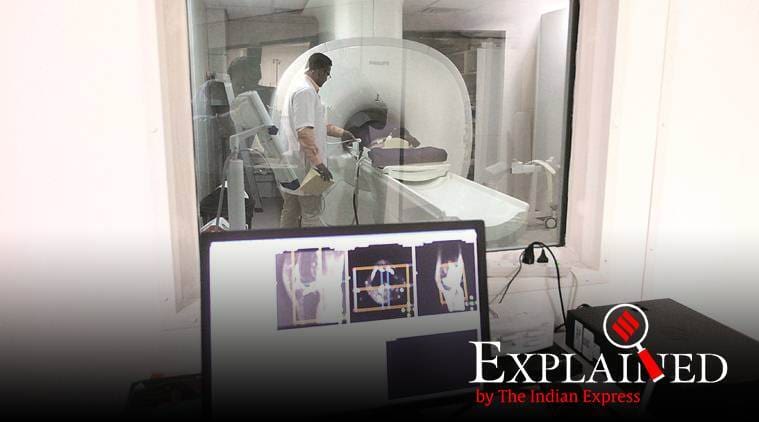In a virtual autopsy, doctors use radiation to examine the innards to reach a conclusion about the cause of death. A CT or an MRI machine could be used, in the same way that they are used to scan a living human’s body.
It is likely to be possible soon to carry out autopsies without dissecting the body, Health Minister Harsh Vardhan told Rajya Sabha on Tuesday. India will be the first country in South and Southeast Asia to carry out these “virtual autopsies”, the Minister said.
So what is a virtual autopsy?
In a virtual autopsy, doctors use radiation to examine the innards to reach a conclusion about the cause of death. A CT or an MRI machine could be used, in the same way that they are used to scan a living human’s body.
A 2013 paper titled ‘Virtopsy (virtual autopsy): A new phase in forensic investigation’ said: “An autopsy (postmortem examination, autopsia cadaverum, or obduction) is a highly specialized surgical procedure that consists of a thorough examination of a corpse to determine the cause and manner of death and to evaluate any disease or injury that may be present. Virtopsy is a word combining ‘virtual’ and ‘autopsy’ … for the purpose of autopsy and to find the cause of the death. Virtopsy can be employed as an alternative to standard autopsies for broad and systemic examination of the whole body as it is less time consuming, aids better diagnosis, and renders respect to religious sentiments.” (Journal of Forensic Dental Sciences; K B Tejaswi and E Aarte Hari Periya)
When is this service likely to start?
In his reply to a starred question from Rewati Raman Singh of the Samajwadi Party, Dr Harsh Vardhan said: “The All India Institute of Medical Science (AIIMS), New Delhi and Indian Council of Medical Research (ICMR) are working together on a technique for postmortem without incising/dissecting the body. This technique is likely to become functional in the next six months.”
But what is the need?
As the Minister acknowledged, the traditional postmortem often makes members of the dead person’s family uncomfortable. That, in fact, is the primary reason for the increasing use of virtual autopsies internationally. Dr Harsh Vardhan said ICMR and AIIMS have studied global practices, and taken up this project for “dignified management of dead body”.
According to a paper in The Lancet, the advent of virtual autopsy owes to the “Longstanding public objection to dissection of cadavers (that) re-emerged in the UK as a major issue after organ retention scandals in the late 1990s. Some groups —notably Jewish and Muslim communities — have religious objections to autopsy, and demand for a minimally-invasive alternative has increased.” (‘Post-mortem imaging as an alternative to autopsy in the diagnosis of adult deaths: a validation study’: 2012, Ian S D Roberts et. al)
A virtual autopsy is also faster than a traditional one — 30 minutes against 2½ hours, Dr Harsh Vardhan said — and more cost-effective.
Is this currently practised anywhere?
According to a 2016 article titled ‘The Rise of Virtual Autopsy’ in the Journal of Forensic Pathology, virtual autopsy began in Sweden, but is now a “standard technique” in major centres in Japan, the US, Australia, and many European countries.
In the 1990s, a “post post-mortem” MRI service for “selected non-suspicious deaths” was introduced in Manchester, UK. This followed demands from the Jewish community for a non-invasive autopsy. Later, the Muslim community in the northwest of England too, joined in the demands.
The Royal College of Pathologists UK has issued guidelines for virtual autopsies.
How accurate is a virtual autopsy?
According to the 2012 paper by Ian S D Roberts and others in The Lancet, “Radiologists provide a cause of death that is accepted by the Coroner with no autopsy in 90% of cases”. In 2018, in an article in the Journal of Pathology Informatics, Russian and Italian scientists compared the results of virtual autopsy and traditional postmortem.
“Out of 23 cases for which the traditional post mortem examination found a cause of death, 15 (65%) were diagnosed correctly using virtual autopsy, these cases were considered as true positives. For one case for which the cause of death was unascertained, the same result was also obtained during the virtual autopsy. This case was considered as true negative. Overall, in 16/25 (64%) cases, virtual autopsy results matched that of the traditional autopsy,” they concluded. (‘Virtual Autopsy as a Screening Test Before Traditional Autopsy: The Verona Experience on 25 Cases’, Vito Cirielli, et. al)

